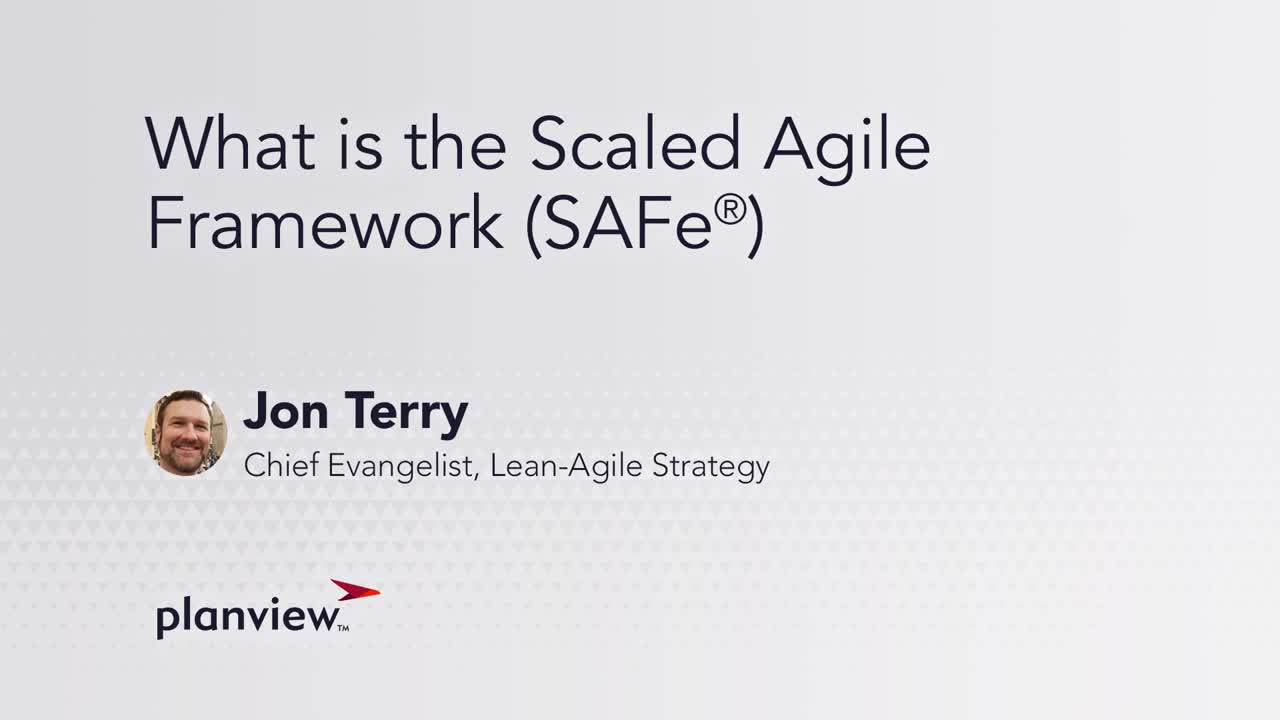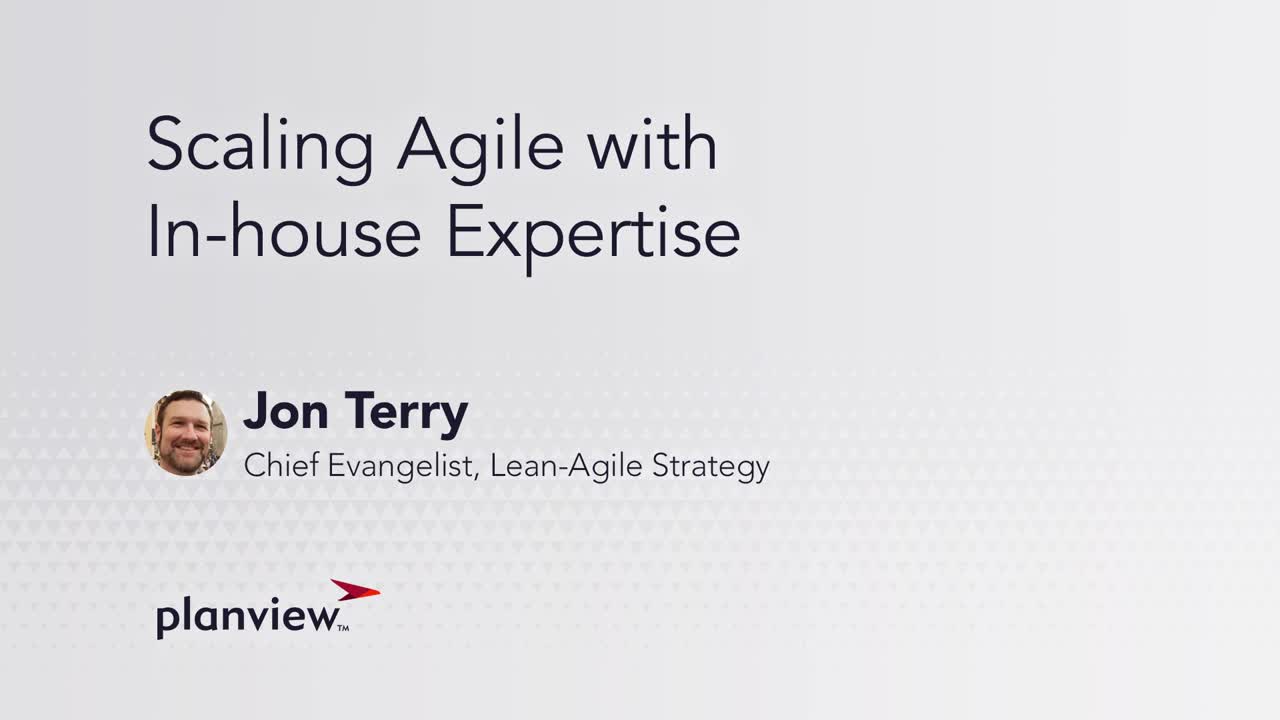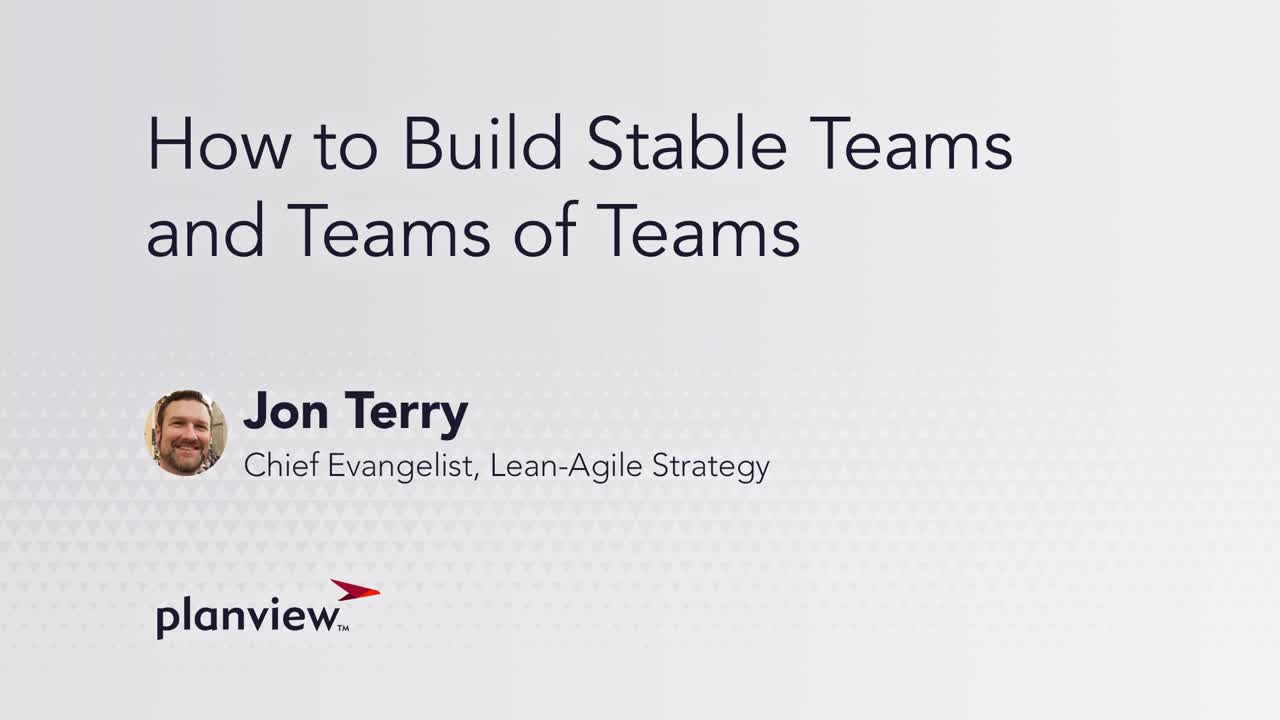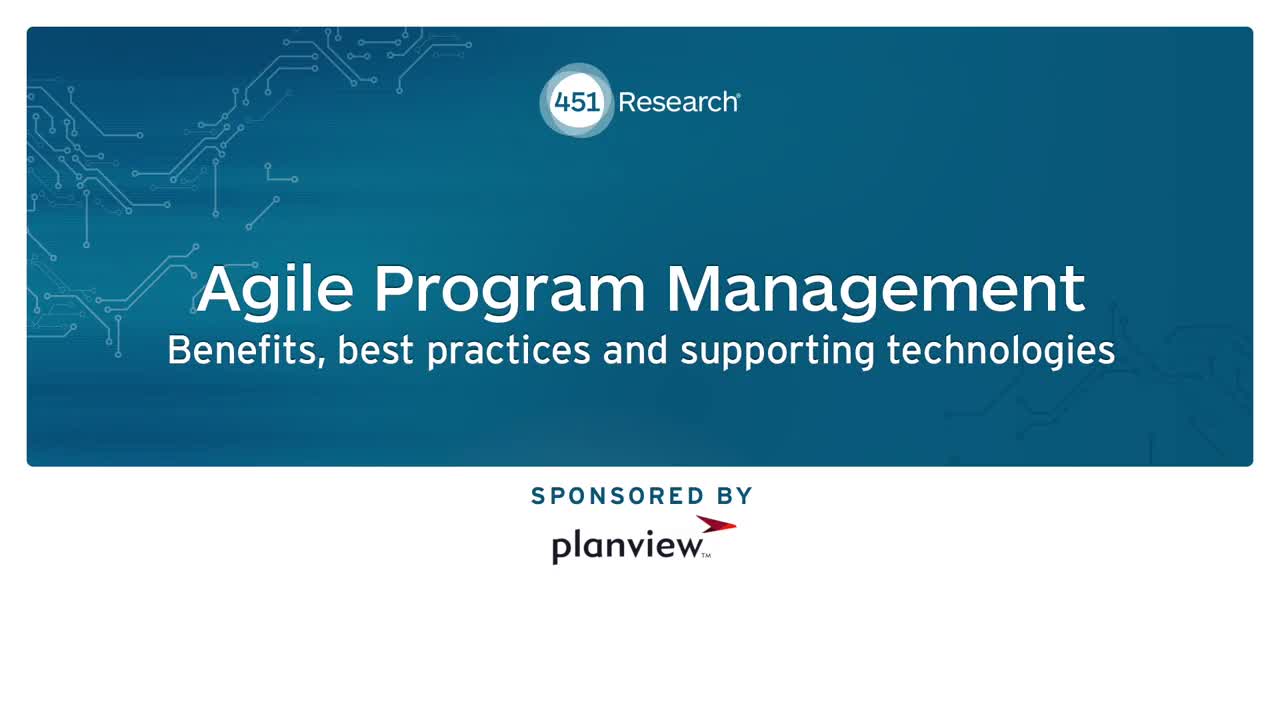Framework für Agile-Skalierung: Wie Technologie Agilität fördert
Die Einführung von SAFe 5.0, einer aktualisierten Version des beliebten Agile-Skalierungsframeworks®, bietet mehr Orientierungshilfen zum Thema geschäftliche Agilität als jemals zuvor. Wenn Sie die Vorteile von Agile in Ihrem gesamten Unternehmen nutzen wollen, sind Sie hier genau richtig.

Erfahren Sie, was SAFe ist, und sehen Sie, wie Planview das Modell mit Boards und Vorlagen unterstützt.
Weltweit merken Unternehmen, dass es an der Zeit ist, ihre geschäftliche Agilität zu steigern – und zwar schnell. Globalisierung, sich dynamisch entwickelnde Märkte, Disruptionen und das beispiellose Tempo technologischer Innovationen machen echte, unternehmensweite Agilität notwendiger denn je.
Wahrscheinlich arbeitet Ihre IT-Organisation schon seit Jahren mit irgendeiner Art von Agile, um die Produkteinführungszeiten zu verkürzen, Ineffizienzen abzubauen und qualitativ hochwertigere Produkte zu erstellen.
Doch was in der Softwareentwicklung begann, weitet sich auf das gesamte Unternehmen aus und verändert die Arbeitsweise der Mitarbeiter im Hinblick auf alle geschäftlichen Aktivitäten. Wir leben in einer vernetzten Echtzeit-Welt, in der jede Branche technologiebasiert und in der jedes Unternehmen – wenigstens zum Teil – ein Softwareunternehmen ist.
Um Agilität im gesamten Unternehmen zu ermöglichen, müssen Unternehmen letztlich Agile über die Softwareentwicklung und die IT hinaus verstehen, anpassen und auf das restliche Unternehmens ausdehnen.
Sie müssen in der Lage sein, ihre Portfoliomanagementpraktiken weiterzuentwickeln, um die geschäftliche Agilität zu steigern und gleichzeitig die Bereitstellung von Arbeit mit den Prioritäten des Unternehmens und den Kundenanforderungen in Einklang zu bringen.
In diesem Leitfaden erörtern wir die Vorteile der Agile-Skalierung, geben Ihnen Tipps und stellen empfohlene Vorgehensweisen für die Implementierung des Agile-Skalierungsframeworks in Ihrem Unternehmen vor.
Warum sollten Sie Agile skalieren?

Es gibt viele Gründe, warum Organisationen nach Wegen zur Agile-Skalierung suchen. Häufig erkennen Führungskräfte die Vorteile ihrer Agile-Teams und sehen in ihrer Skalierung die Chance, umfangreichere und komplexere Initiativen anzugehen. Es erfordert allerdings deutlich mehr Koordination und Planung, um ähnlich gute Ergebnisse im großen Maßstab zu erreichen wie in einzelnen Teams.

Unternehmen versuchen sich aktuell zunehmend an einer Agile-Skalierung.
Nachfolgend einige häufige Gründe, warum sich Unternehmen für eine Agile-Skalierung entscheiden:
- Die Anzahl der Teams nimmt zu, ihre Arbeit ist aber nicht auf ein gemeinsames Ziel ausgerichtet.
- Umfangreichere Projekte zeichnen sich ab, und die Teams sind sich nicht im Klaren, wie die Arbeit zwischen ihnen heruntergebrochen und verteilt werden soll.
- Agile Prozesse, Zeremonien und Teamrollen sind schlecht definiert, wodurch die Koordination der Teams zu einer noch größeren Herausforderung wird.
- Qualität und Geschwindigkeit leiden, weil mehr Teams in den Prozess des Herunterbrechens von Projekten und Initiativen involviert sind. Dies führt häufig zu einem Scheitern der Kommunikation, wodurch viele Teams den Glauben an den Prozess als Ganzes verlieren.
Unternehmen beginnen auch, nach Möglichkeiten zur Agile-Skalierung zu suchen, wenn sie erkennen, dass sie einen besseren Weg benötigen, um die komplexen und sich ständig weiterentwickelnden Herausforderungen besser bewältigen zu können. Sie müssen in der Lage sein, große und komplexe Unternehmensinitiativen in kleinere, umsetzbare Teilprojekte zu verwandeln, die einen liefer- und messbaren Nutzen stiften, der über das gesamte Portfolio hinweg verfolgt und gemessen werden kann.

Auf Portfolio- und Programmebene wechseln wir von einer „Plan vs. Ist“-Betrachtung zu einem Fokus auf die Ergebnisse.
Sie müssen Innovationen vorantreiben, den Kundennutzen schneller steigern, den Wettbewerb übertreffen, Disruptionen am Markt erzeugen und Chancen so schnell nutzen, wie sie entstehen – nicht nur in der IT- oder Softwareentwicklung, sondern auch im Vertrieb, Kundensupport, Marketing, Finanzbereich und Personalwesen. An dieser Stelle kommt das Agile-Skalierungsframework ins Spiel.
Vorteile der Agile-Skalierung
Mit Agile-Skalierung ist Fortschritt bei der Ausweitung der Prozesse, Praktiken, Werte und Vorteile von Agile gemeint, um den Anforderungen des Unternehmens gerecht zu werden. Wenn Sie diesen Leitfaden lesen, dann sind Sie wahrscheinlich daran interessiert, die Vorteile der Agile-Skalierung in Ihrem Team oder Unternehmen zu realisieren.
Ob Ihr Ziel darin besteht, die Innovationsfähigkeit Ihres Unternehmens zu steigern, das Entwickeln von Lösungen proaktiver zu machen oder einfach nur die Effizienz Ihres Planungs- und/oder Workflow-Managements zu verbessern – Agile kann Sie bei all diesen Zielen unterstützen.
| Agile ermöglicht: | Durch: |
|---|---|
| Effizientere Planung und besseres Workflow-Management | Förderung von Prozessvisualisierung, Workflow-Transparenz und kürzeren Planungszyklen |
| Optimierte Finanzierungs- und Kostenrechnungspraktiken | Förderung der Akzeptanz dynamischerer Lean-/Agile-Finanzierungs-, Kostenrechnungs- und Projektmanagementmethoden |
| Größere Transparenz im gesamten Unternehmen | Förderung des Einsatzes von visuellen Management-Tools |
| Bessere Ausrichtung der Teamaktivitäten an der Unternehmensstrategie | Anregen regelmäßiger Gespräche über die Strategie mithilfe einer Program Increment-Planung (PI-Planung) und der Verwendung von Agile Tools wie „Objectives and Key Results“ (OKRs) |
| Verbesserung der Fähigkeit, auf Marktveränderungen zu reagieren | Kürzere Planungszyklen sowie anpassungsfähigere Governance- und Finanzierungspraktiken |
| Proaktive statt reaktive Entwicklung von Lösungen | Eine Betonung der Zusammenarbeit mit Kunden und ihrem Feedback |
| Verbesserte Fähigkeit zur Vorhersage und Reaktion auf Disruptionen am Markt | Continuously gathering customer feedback; operating in short feedback loops |
| Erhöhte Stabilität und Nachhaltigkeit des Unternehmens | Entwicklung langlebiger und autarker Teams |
SAFe 5.0 Aufschlüsselung
Wie genau können Sie also bei der Agile-Skalierung in Ihrem Unternehmen vorgehen?
Mit der Veröffentlichung von SAFe 5.0 gibt es nun sieben Kernkompetenzen für ein Lean-Unternehmen, eine Steigerung gegenüber den fünf Kompetenzen, die in SAFe 4.6 eingeführt wurden. Diese Liste der Kompetenzen wurde erweitert, um die geschäftliche Agilität in modernen Unternehmen zu unterstützen. Hinzugefügt wurden die Kompetenzen „Organizational Agility“ (geschäftliche Agilität) und „Continuous Learning“ (kontinuierliches Lernen).
Jede dieser Kompetenzen besteht aus mit ihr zusammenhängenden Kenntnissen, Fähigkeiten und Verhaltensweisen, durch die Unternehmen geschäftliche Agilität erreichen können. Es ist ein bewährter Weg zu geschäftlicher Agilität, Schritte zu unternehmen, um sich in jeder dieser Kernkompetenzen weiterzuentwickeln.
Nachfolgend eine kurze Zusammenfassung der sieben Kernkompetenzen und wie sie Ihr Unternehmen dabei unterstützen können, geschäftliche Agilität zu erreichen.
Kernkompetenzen eines schlanken Unternehmens (Lean Enterprise)

Lean-Agile-Führung
Für eine erfolgreiche Agile-Skalierung benötigen Unternehmen disziplinierte Lean-Agile-Führungskräfte. Die Agile-Skalierung erfordert von den Führungskräften, dass sie nachhaltige Veränderungen vorantreiben und aufrechterhalten, indem sie einzelne Mitarbeiter und Teams befähigen, ihr Potenzial auszuschöpfen und ihren Fokus auf die Maximierung des Kundennutzens zu richten.
Der Hauptunterschied zwischen Agile-Teams und Lean-Agile-Führungskräften liegt in den jeweiligen Verantwortlichkeiten: Während Teams einen praktischen Ansatz verfolgen, um Probleme zu lösen und Nutzen zu stiften, überwachen Führungskräfte den Fortschritt dieser Teams und unterstützen sie dabei, im Falle einer Blockade Hindernisse zu beseitigen und Arbeit neu zuzuweisen.
Eine agile Führungskraft ist auch dafür verantwortlich, einen offenen Kommunikationskanal zwischen dem Management und den einzelnen Teammitgliedern aufrechtzuerhalten. Führungskräfte und Teammitglieder müssen die Möglichkeit haben, Fragen zu stellen und Antworten zu erhalten, Feedback zu geben und gemeinsam den weiteren Weg kreativ zu entwickeln. Von agilen Führungskräften wird erwartet, Mikromanagement zu vermeiden und sich stattdessen auf die strategische Richtung zu konzentrieren, die das Unternehmen einschlägt, und den Value Streams den notwendigen Raum zu verschaffen, um die Arbeit abzuschließen.
Team- und technische Agilität
Team- und technische Agilität beschreiben im Agile-Skalierungsframework diejenigen Prinzipien und Praktiken, die Agile-Teams anwenden, um Lösungen effizient bereitzustellen, die ihren Kunden zusätzlichen Nutzen bringen.
Im Ergebnis führen diese Praktiken zu erhöhter Produktivität, besserer Qualität, schnellerer Markteinführung und der planbaren Bereitstellung von Nutzen.
Wichtig ist, festzuhalten, dass SAFe 5.0 das Entwicklerteam bei der Beschreibung von Agile-Teams fallen gelassen hat. Dies ist ein Wink für geschäftliche Teams außerhalb der IT und zeigt, dass das Framework über die IT- / Software-Entwicklung hinausgeht, um auch geschäftliche Agilität zu integrieren.
Agile-Produktbereitstellung
Agile-Skalierung ermöglicht es Unternehmen, einen kundenzentrierten Ansatz für die Definition, Erstellung und Freigabe wertvoller Produkte und Dienstleistungen in einem kontinuierlichen Flow zusammenzufassen, der als Agile-Produktbereitstellung bezeichnet wird. Agile-Produktbereitstellung unterstützt Unternehmen dabei, Lösungen zu entwickeln, die dem Kunden einen größeren Nutzen bieten, während gleichzeitig Entwicklungskosten und Risiko reduziert werden.
Bereitstellung von Unternehmenslösungen
Moderne Unternehmen verlassen sich auf die weltgrößten und ausgereiftesten Softwareanwendungen, Netzwerke und cyber-physischen Systeme. Enterprise Solution Delivery beschreibt den Prozess der Anwendung von Lean-Agile-Prinzipien und -Praktiken auf die Spezifikation, die Entwicklung, das Deployment, den Betrieb und die Weiterentwicklung dieser Softwarelösungen.
Lean-Portfoliomanagement
Innerhalb der Agile-Skalierung bringt Lean Portfoliomanagement (LPM) die Strategie und die Umsetzung in Einklang. Dies erfolgt durch die Anwendung von Lean-Agile-Denken auf die Art und Weise, wie Projekte geplant, finanziert und umgesetzt werden.
Das Lean Portfoliomanagement ermutigt Unternehmen dazu, über ein Herunterbrechen Ihrer Planungs- und Finanzierungszyklen in kleinere und iterative Teile nachzudenken – ähnlich wie Agile-Arbeit in kleinere Pakete aufgeteilt wird.
Die Schlüsselkomponenten des Lean-Portfoliomanagements (LPM) beinhalten eine Änderung, wie ein Unternehmen folgende Aspekte handhabt:
- Strategie und Investitionsfinanzierung
- Agile-Portfolioabläufe
- Lean-Governance
Betriebliche Agilität
Experten bei McKinsey & Company definieren den Begriff „geschäftliche Agilität“ als „… die Fähigkeit, Strategie, Struktur, Prozesse, Mitarbeiter und Technologie schnell in Richtung Nutzen bringender und bewahrender Chancen umzugestalten …“ Im Rahmen der Agile-Skalierung beschreibt geschäftliche Agilität, wie Agile-Teams ihre Geschäftsprozesse und -praktiken optimieren, um ihre Fähigkeit zu verbessern, neue Chancen zu nutzen.
Kultur kontinuierlichen Lernens
Die Kultur des kontinuierlichen Lernens bei der Agile-Skalierung beschreibt schließlich eine Reihe von Werten und Praktiken, die den Einzelnen und das Unternehmen als Ganzes dazu ermutigen sollen, Wissen, Kompetenz, Leistung und Innovationsfähigkeit kontinuierlich zu steigern. Das Schaffen einer Kultur kontinuierlichen Lernens beinhaltet:
- Das Priorisieren von Lernmöglichkeiten neben der regulären Arbeit
- Das Ermutigen zum Lernen als vorrangiges Ziel
- Das kontinuierliche Schaffen von Weiterbildungsmöglichkeiten für Mitarbeiter
- Das Bereitstellen von Systemen, die den Informationsaustausch im gesamten Unternehmen ermöglichen
So unterstützt Technologie ein Framework für Agile-Skalierung
Unabhängig von der Branche oder den Branchen, in denen Sie tätig sind, verlässt sich Ihr Unternehmen auf ein komplexes Netzwerk aus Softwarelösungen – in Form von Anwendungen, Netzwerken und Infrastruktur –, das Agilität im großen Maßstab ermöglichen, aber auch verhindern kann.
Eines der Hauptziele der Agile-Skalierung liegt in der Erhöhung der Transparenz im gesamten Unternehmen. Dies trägt nicht nur dazu bei, Strategie und Umsetzung aufeinander abzustimmen, sondern ermöglicht es auch allen Mitarbeitern im Unternehmen, Möglichkeiten zur Beschleunigung der Bereitstellung, zur Steigerung der Produktqualität, zur Reduzierung der teamübergreifenden Abhängigkeiten und so letztendlich zur Schaffung von Feedbackschleifen für eine kontinuierliche Optimierung zu identifizieren, wodurch ein nachhaltigeres Werterbringungssystem geschaffen werden kann.

Wenn Ihre Teams jedoch mit unterschiedlichen Tools arbeiten, ist es fast unmöglich, die für die Agile-Skalierung erforderliche Transparenz zu erreichen. Es ist unerlässlich, nach Möglichkeiten zu suchen, veraltete Systeme zu aktualisieren, zu modifizieren, zusammenzuführen und zu überdenken, um ein Technologiesystem zu schaffen, das die Agile-Skalierung unterstützt.
Wie im Diagramm zu sehen, kann dies Folgendes beinhalten:
- Das Überdenken, wie Ihr Unternehmen die strategische und jährliche Planung durchführt
- Das Sicherstellen von Unterstützung, sodass Ihr Unternehmen Value-Stream-Prioritäten erstellen, finanzieren und planen und seine Arbeit auf Teams of Teams herunterbrechen kann, wobei Transparenz hinsichtlich der geleisteten Arbeit und des ROI besteht
- Das Bereitstellen einer Möglichkeit für verstreute Teams, ihre Arbeit in einem einzigen System visuell zu verwalten, zu planen und zu koordinieren, um Abhängigkeiten zu reduzieren und die Bereitstellung durch das Team zu beschleunigen

Teams of Teams arbeiten zusammen, um ein gemeinsames Ziel zu erreichen: größere Produkte oder Value Streams im Sinne des Unternehmens.
Es gibt jedoch Möglichkeiten, die Kommunikationslücken zwischen den in einem Unternehmen genutzten Tools zu überbrücken und so ein transparentes Gesamtbild zu schaffen, ohne dabei den Detailgrad zu opfern, den Ihre Teams für die tägliche Arbeit brauchen. Mit dem Aufkommen von Agile ist eine wachsende Anzahl von Agile-Tools für Unternehmen entstanden, die Lean- und Agile-Bereitstellung in komplexen Organisationen ermöglichen.
Die spezifischen Kriterien für die Bewertung von Agile-Softwarelösungen variieren abhängig von der Größe, dem Reifegrad und den Zielen Ihres Unternehmens. Für Unternehmen ist es wichtig, ein Tool auszuwählen, das eine Kultur kontinuierlichen Lernens und Optimierens fördert und Ihr Unternehmen dabei unterstützt, seine strategischen Ziele im Auge zu behalten.

Die optimale Projektmanagement-Anwendung für Teams aller Größenordnungen
Melden Sie sich mit Ihrem ersten Projekt an, und laden Sie Ihr Team kostenlos ein.
ProjectPlace Free Trial Full-functional 30-day trial • Planview projectplace-thick